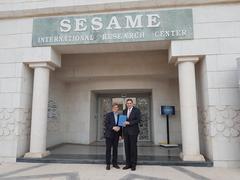URL: https://www.desy.de/news/news_search/index_eng.html
Breadcrumb Navigation
DESY News: Helmholtz Association funds particle accelerator SESAME with 3.5 million Euro
News
News from the DESY research centre
Helmholtz Association funds particle accelerator SESAME with 3.5 million Euro
SESAME in Jordan is the only synchrotron radiation source in the Middle East. The Helmholtz Association has now decided to fund it with 3.5 million Euros as part of a new project, Helmholtz President Otmar D. Wiestler announced during a visit to SESAME on Thursday. The money will be used to build a new, state-of-the-art beam guidance system in the soft X-ray range at SESAME that can be used for a variety of relevant scientific applications.

Helmholtz president Otmar Wiestler and SESAME Director Khaled Toukan. Image: DESY
SESAME (Synchrotron-light for Experimental Science and Application in the Middle East) is a third-generation synchrotron radiation source that went into operation in 2017. Scientists can carry out structural investigations with X-rays - from the fluoroscopy of new materials to the analysis of biomolecules. During the four-year project, a Helmholtz consortium consisting of five German research centres (DESY, Forschungszentrum Jülich FZJ, Helmholtz-Zentrum Dresden-Rossendorf HZDR, Helmholtz-Zentrum Berlin HZB and Karlsruhe Institute of Technology KIT) will plan, design and install a new beam guidance system for soft X-ray radiation at SESAME. Two new experimental stations are to be set up, which will be financed from additional funds from the SESAME member states. During the project’s runtime, the initiative is to serve as a starting point for the formation of international user consortia, which will contribute to the construction and development of experimental stations, special sample environments and other instruments.
SESAME and DESY have a long history of cooperation. The idea for the synchrotron facility was born in 1997 by the then-DESY accelerator director Gustav-Adolf Voss and the US researcher Herman Winick from the SLAC accelerator centre in California. They wanted to promote the development of science in the Middle East; parts of the facility even come from particle accelerators in Germany.
In 2004, SESAME was launched as an international project. Egypt, Iran, Israel, Jordan, Pakistan, the Palestinian Authority, Turkey and Cyprus are jointly involved in this project. "In a very sensitive political region, this unique cooperation brings together people who carry out top-class science and who also interact other across borders through this science," says SESAME Council President Rolf Heuer, former CERN Director General and former DESY Research Director. "This unique research project is therefore not only of great importance for this region scientifically, but also in terms of international understanding.”
Since the foundation of SESAME, Germany has participated as an observer in the international SESAME Council. DESY assumes this role on behalf of the Federal Ministry of Education and Research (BMBF). "I am very pleased that we are now continuing SESAME's success story," says DESY Director Helmut Dosch. "The ultra-modern beam guidance will enable a multitude of scientifically excellent applications and thus promote new cooperations at SESAME".
The visit to SESAME in Jordan was part of a larger Helmholtz delegation trip to the Middle East. The aim is to further intensify cooperation with the region. A new Helmholtz International Office was also opened in Tel Aviv as a basis for this. The Helmholtz Association is one of the pioneers of scientific cooperation with Israel. "We chose this location because we perceive incredible dynamics in our long-standing cooperation with Israeli partners," says Helmholtz President Wiestler. "In many scientific fields such as medicine, chemistry or physics, environmental or energy research, the state offers top-level science at an international level. Israel is a world leader in the broad field of digitisation. That is why we want to use our excellent foundations to achieve a new quality of cooperation and a new dimension of partnership."
DESY is also striving to expand its cooperation with Israeli research institutions. "We have a long and fruitful cooperation with a number of partners in Israel," says DESY Director Helmut Dosch. "We want to expand this success story by strengthening existing collaborations and establishing new ones.”



